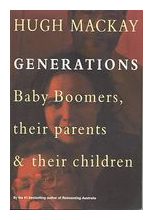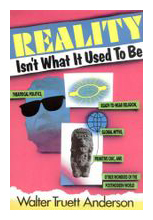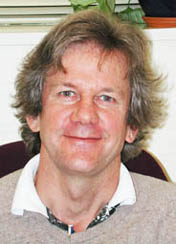 Hugh Mackay’s third generational slice is the first wave of children of early Baby Boomers, born in the 1970s. These people are now aged from twenty five to thirty five. In 1997, when Mackay’s book, “Generations” was published, they were seventeen to twenty seven.
Hugh Mackay’s third generational slice is the first wave of children of early Baby Boomers, born in the 1970s. These people are now aged from twenty five to thirty five. In 1997, when Mackay’s book, “Generations” was published, they were seventeen to twenty seven.
Mackay identifies a number of patterns emerging from his research with this age group.
Individuality
Although there is a conformity in dress, slang and attitudes, Mackay’s subjects do not want to be lumped together under one generalisation. Unlike the Boomers, they’re not flattered with labels. At the end of his section on the Options generation, Mackay makes the comment:
“When members of the Options Generation plead to be regarded as individuals, they have a point: considering that the kaleidoscope of social change creates unpredictable patterns, the process of adaptation is bound to be highly individualistic. … They are the products of fragmentation, diversity and unpredictability.”
Options Open
Mackay observes that this generation have learned to postpone long-term commitments in favour of short-term goals and temporary solutions. They’ve grown up in an environment marked by constant change and uncertainty. They live and breathe it without the anxiety of their parents or grandparents.
This generation take for granted gender equality in education and employment. They expect both parents to be working outside the home but know that they themselves face the likelihood of unemployment. Family configuration is hardly a talking point as there is little sense of ‘normal family life’. This generation in Australia have grown up with the idea of multiculturalism, have little sense of connection with the Britain’s royalty, and have always been aware of AIDS. The guys in particular face a relatively high rate of suicide compared with previous generations and other parts of the world.
Mackay comments on this generation’s preference to ‘remain as non-committal as possible, for as long as possible’. Stability and predictability – even as goals – seem rather incongruous. Older generations are puzzled by the resulting reluctance to make long-term commitments to one course of study, one job, one sexual partner, one political party, one set of religious beliefs. What appears to be apathy or premature conservatism is more a case of ‘making it up as we go along’ – pouring passion and commitment into short term goals.
Here I find Mackay carefully comparing this generation with earlier generations at a similar life stage. Previous generations had expectations about a ‘preordained sequence of events’ surrounding marriage, family and long-term career. This slice of Australians can see that the future is much more open than that.
Independence Paradox
If the Baby Boomers carved out adolesence as a life stage, the Options Generation took adolesence and stretched it out into their twenties. They are likely to stay at home longer, study longer and look for more government income support (unemployment benefit). The challenge in all this is the development of a sense of independence linked with handling flexibility, voluntarily and involuntarily. That independence must be linked a mental framework that isn’t tied to employment.
Moral Boundary Riders
“Boundary-rider” is an Australian term for a person responsible for the maintenance of fences on a station or stock farm. It’s also slang for a sports journalist who reports from the side lines and can interview players during the course of the game.
Mackay tells us that because of the delay in finding long-term employment, the Options generation have extended the years of rebellion. Anti-social behaviour linked with sex, alcohol, drug abuse, non-conformist hair, clothes and language, carries on into the twenties. These twenty somethings test the limits as they build their own moral framework through reflection on experience.
 It’s here that Mackay uses Walter Truett Anderson to explore the development of home grown systems of morality, as expressed in Anderson’s book, Reality Isn’t What It Used To Be. Anderson argues that morality is the product of hard-won wisdom and is constructed and reconstructed throughout life. Mackay points out that while many young Australians do not explicitly identify the moral issues they face, they are forced to make decisions about lifestyle eventually.
It’s here that Mackay uses Walter Truett Anderson to explore the development of home grown systems of morality, as expressed in Anderson’s book, Reality Isn’t What It Used To Be. Anderson argues that morality is the product of hard-won wisdom and is constructed and reconstructed throughout life. Mackay points out that while many young Australians do not explicitly identify the moral issues they face, they are forced to make decisions about lifestyle eventually.
Mackay expresses concern that despair, depression and alienation are all that is left for those young people who find no meaning in education, live in discouraging family environments or become rejected by hostile labour markets.
On the other hand, Mackay reminds us, there are many young people who take the initiative and move from hedonist nihilism to a positive, constructive approach to life. Some of these will buy into religious fundamentalism, impatient with the journey of ambiguities. Others will attempt to live life to the max.
Marriage and Family? Not Yet, Thanks
If the Lucky Generation saw marriage as an end in itself, and the Boomers focused more on the quality of the marriage relationship, the Options generation tend to focus on the quality of relationship, with marriage as a secondary consideration. A good relationship may last ten years or a lifetime, and may or may not be recognised legally. Friendship is valued over sex. The Options generation don’t tend to pair off early as the Boomers did. They postpone marriage and parenthood as long as possible. Mackay notes that the parenthood is the significant milestone in a relationship rather than the wedding.
It’s at this point that Mackay refers to the ‘Post Boomers’ – born in the 1960s. (Hurrah!) These products of a child-centred culture now focus on ‘creating a lifestyle’ that is less child centred. It’s the Friends and Seinfeld generation we’re talking about here.
There’s an expectation that members of the Options generation will have several serious sexual relationships along the way to marriage. And that there may be more than one marriage. Women, in particular, have less sense than their mothers of needing marriage as a ‘passport to identity or security’.
The ideal, for this generation, is to establish themselves financially, develop a strong and successful emotional relationship, and then decide whether or not to get married and have children. There’s a sense of realism that lacks romantic edge.
The children of the Option Generation are likely to experience more time in child care centres than those of previous generations.
Mackay notes that Options women have set themselves the goal of experiencing the full range of options available to them, but not all at once.
Gender Revolution
Men and women are equal but different. Equal opportunities for men and women should be taken for granted. Men and women should be able to negotiate roles and responsibilities at home and work in ways which respect the needs and preferences of each.
These are the professed values prevalent in the people Mackay talked to. Women live and breathe them. Men aspire to them but struggle to put them into practice. Mackay points out that the messages from these guys’ mothers were in conflict with the examples of their fathers.
An interesting development is the capacity of this generation’s women to maintain close relationships with members of the opposite gender without implying sexual attraction or entanglements. However these women are still prone to experience prejudice, sexual harrassment and discrimination, particularly from men of older generations.
Concluding thoughts
 Mackay refers his readers to the 1996 research on young people’s attitudes to technology commissioned by Australian Science, Technology and Engineering Council. (Due to government restructuring this group is now known as the Prime Minister’s Science, Engineering and Innovation Council.) Richard Eckersley resulting address to the Australian Secondary Principal’s Association is available online at www.aspa.asn.au/conecker.htm
Mackay refers his readers to the 1996 research on young people’s attitudes to technology commissioned by Australian Science, Technology and Engineering Council. (Due to government restructuring this group is now known as the Prime Minister’s Science, Engineering and Innovation Council.) Richard Eckersley resulting address to the Australian Secondary Principal’s Association is available online at www.aspa.asn.au/conecker.htm
Eckersley (see his web site) points out that only one third of people surveyed believed that life would be better in 2010 than in 1996. The postponement of commitment, grounded in cynicism and disillusion, could lead to a civilisation without confidence or reference points.
Mackay reflects on his impression that pop culture is more kaleidoscopic than it was in the 1950s, 1960s and 1970s. There is no one kind of music that reaches all members of the Options Generation. Rock music itself, since the days of punk music, has become more artist driven, spinning off into a large number of genres each with their own fan base.
Interviewees from the Option Generation were concerned that younger teenagers were in danger of being sucked into a new cultural conformity, ‘shaped by the idioms of the information revolution’.
Mackay’s finishes his book with the thought that the Option Generation can teach their elders how to live with ambiguity and uncertainty without fear.
